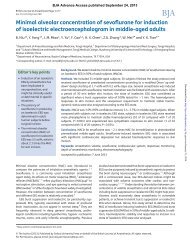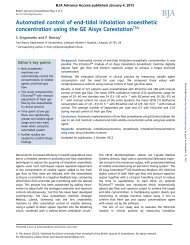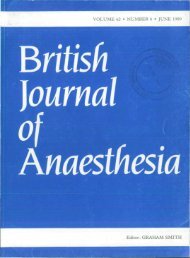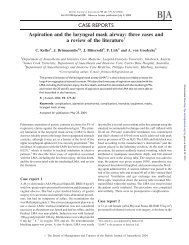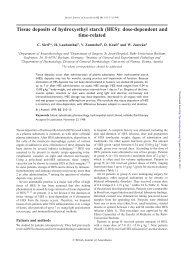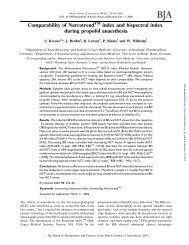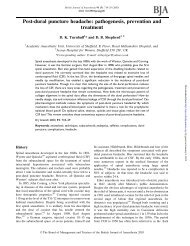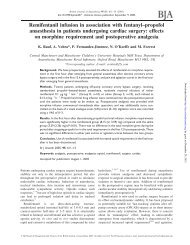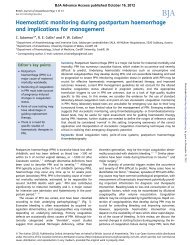CRITICAL CARE Effects of hydroxyethyl starch administration ... - BJA
CRITICAL CARE Effects of hydroxyethyl starch administration ... - BJA
CRITICAL CARE Effects of hydroxyethyl starch administration ... - BJA
You also want an ePaper? Increase the reach of your titles
YUMPU automatically turns print PDFs into web optimized ePapers that Google loves.
<strong>CRITICAL</strong> <strong>CARE</strong><br />
<strong>Effects</strong> <strong>of</strong> <strong>hydroxyethyl</strong> <strong>starch</strong> <strong>administration</strong> on renal function<br />
in critically ill patients †‡<br />
Y. Sakr 1 ,D.Payen 2 , K. Reinhart 1 , F. S. Sipmann 3 , E. Zavala 4 , J. Bewley 5 ,<br />
G. Marx 1 and J.-L. Vincent 6 *<br />
1 Friedrich-Schiller-University, Jena, Germany. 2 Centre Hospitalier Universitaire Lariboisiere, Paris, France.<br />
3 Fundación Jiménez Díaz, Madrid, Spain. 4 Hospital Clinic <strong>of</strong> Barcelona, Spain. 5 Bristol Royal Infirmary,<br />
Bristol, UK. 6 Erasme Hospital, Free University <strong>of</strong> Brussels, Belgium on behalf <strong>of</strong> the ‘Sepsis Occurrence in<br />
Acutely Ill Patients’ investigators<br />
*Corresponding author: Department <strong>of</strong> Intensive Care, Erasme University Hospital, Route De Lennik 808,<br />
1070 Brussels, Belgium. E-mail: jlvincen@ulb.ac.be<br />
Background. The influence <strong>of</strong> <strong>hydroxyethyl</strong> <strong>starch</strong> (HES) solutions on renal function is controversial.<br />
We investigated the effect <strong>of</strong> HES <strong>administration</strong> on renal function in critically ill<br />
patients enrolled in a large multicentre observational European study.<br />
Methods. All adult patients admitted to the 198 participating intensive care units (ICUs)<br />
during a 15-day period were enrolled. Prospectively collected data included daily fluid <strong>administration</strong>,<br />
urine output, sequential organ failure assessment (SOFA) score, serum creatinine<br />
levels, and the need for renal replacement therapy (RRT) during the ICU stay.<br />
Results. Of 3147 patients, 1075 (34%) received HES. Patients who received HES were older<br />
[mean (SD): 62 (SD 17) vs 60 (18) years, P¼0.022], more likely to be surgical admissions, had a<br />
higher incidence <strong>of</strong> haematological malignancy and heart failure, higher SAPS II [40.0 (17.0) vs<br />
34.7 (16.9), P,0.001] and SOFA [6.2 (3.7) vs 5.0 (3.9), P,0.001] scores, and less likely to be<br />
receiving RRT (2 vs 4%, P,0.001) than those who did not receive HES. The renal SOFA score<br />
increased significantly over the ICU stay independent <strong>of</strong> the type <strong>of</strong> fluid administered.<br />
Although more patients who received HES needed RRT than non-HES patients (11 vs 9%,<br />
P¼0.006), HES <strong>administration</strong> was not associated with an increased risk for subsequent RRT in<br />
a multivariable analysis [odds ratio (OR): 0.417, 95% confidence interval (CI): 0.05–3.27,<br />
P¼0.406]. Sepsis (OR: 2.03, 95% CI: 1.37–3.02, P,0.001), cardiovascular failure (OR: 6.88,<br />
95% CI: 4.49–10.56, P,0.001), haematological cancer (OR: 2.83, 95% CI: 1.28–6.25, P¼0.01),<br />
and baseline renal SOFA scores.1 (P,0.01 for renal SOFA 2, 3, and 4 with renal SOFA¼0 as<br />
a reference) were all associated with a higher need for RRT.<br />
Conclusions. In this observational study, haematological cancer, the presence <strong>of</strong> sepsis,<br />
cardiovascular failure, and baseline renal function as assessed by the SOFA score were independent<br />
risk factors for the subsequent need for RRT in the ICU. The <strong>administration</strong> <strong>of</strong> HES<br />
had no influence on renal function or the need for RRT in the ICU.<br />
Br J Anaesth 2007; 98: 216–24<br />
Keywords: complications, renal; fluids, i.v.; <strong>hydroxyethyl</strong> <strong>starch</strong>; kidney, failure<br />
Accepted for publication: May 17, 2006<br />
Hydroxyethyl <strong>starch</strong> (HES) solutions are synthetic colloids<br />
with pharmacological properties that are closest to natural<br />
colloids. 1 Apart from being a pure volume expander, the<br />
use <strong>of</strong> HES in the context <strong>of</strong> sepsis has been associated<br />
with a reduction in the circulating levels <strong>of</strong> adhesion<br />
British Journal <strong>of</strong> Anaesthesia 98 (2): 216–24 (2007)<br />
doi:10.1093/bja/ael333<br />
molecules, 2 thus potentially reducing endothelial activation<br />
and damage. Additionally, HES may exert useful<br />
† Declaration <strong>of</strong> interest. Supported by an unlimited grant from Abbott,<br />
Baxter, Eli Lilly, GlaxoSmithKline, and NovoNordisk.<br />
‡ This article is accompanied by Editorial I.<br />
# 2007 The Author(s). This is an Open Access article distributed under the terms <strong>of</strong> the Creative Commons Attribution Non-Commercial License (http://creativecommons.org/<br />
licenses/by-nc/2.0/uk/) which permits unrestricted non-commercial use, distribution, and reproduction in any medium, provided the original work is properly cited.<br />
Downloaded from<br />
http://bja.oxfordjournals.org/ by guest on January 16, 2013
effects on the microvascular coagulation cascade by elevating<br />
levels <strong>of</strong> protein C and protein S. 3 Numerous HES<br />
preparations are available with different combinations <strong>of</strong><br />
concentration, weight-averaged mean molecular weight,<br />
and <strong>hydroxyethyl</strong>ation patterns. 1<br />
The high cost <strong>of</strong> albumin has promoted the more widespread<br />
use <strong>of</strong> HES solutions. However, there is continuing<br />
concern regarding the possible adverse effects <strong>of</strong> HES<br />
including coagulopathy, anaphylactoid reactions, 4 and<br />
renal impairment. Cases <strong>of</strong> acute renal failure or osmotic<br />
nephrosis-like lesions in biopsy specimens have been<br />
reported and were thought to be related to HES use. 5–8<br />
Several small studies 9–16 have yielded conflicting results,<br />
some implicating HES use in the deterioration <strong>of</strong> renal<br />
function, and others refuting this relationship.<br />
We investigated the effect <strong>of</strong> HES <strong>administration</strong> on<br />
renal function in patients included in a large European<br />
database <strong>of</strong> 3147 critically ill patients from the Sepsis<br />
Occurrence in Acutely ill Patients (SOAP) study. 17<br />
Methods<br />
The SOAP study was a prospective, multicentre, observational<br />
study designed to evaluate the epidemiology <strong>of</strong> sepsis<br />
as well as other characteristics <strong>of</strong> intensive care unit (ICU)<br />
patients in European countries. Recruitment, data collection,<br />
and management are detailed elsewhere. 17 Briefly, all<br />
patients .15 yr old admitted to one <strong>of</strong> the 198 participating<br />
centres (see Appendix 1 for a list <strong>of</strong> participating<br />
countries and centres) between May 1 and May 15, 2002<br />
were included. We excluded patients who stayed in the ICU<br />
for less than 24 h for routine postoperative observation.<br />
Patients were followed up until death, hospital discharge, or<br />
for 60 days. Owing to the observational nature <strong>of</strong> the study,<br />
institutional review board approval was either waived or<br />
expedited in participating institutions and informed consent<br />
was not required. Data were collected prospectively using<br />
pre-printed case report forms. Data collection on admission<br />
included demographic data and comorbidities. Clinical and<br />
laboratory data for the simplified acute physiology (SAPS)<br />
II score 18 were reported as the worst value within 24 h after<br />
admission. Microbiological and clinical infections were<br />
reported daily as well as the antibiotics administered. A<br />
daily evaluation <strong>of</strong> organ function according to the sequential<br />
organ failure assessment (SOFA) score (Appendix 2,<br />
Table A1), 19 was performed, with the most abnormal value<br />
for each <strong>of</strong> the six organ systems (respiratory, renal, cardiovascular,<br />
hepatic, coagulation, and neurological) being collected<br />
on admission and every 24 h thereafter.<br />
Sepsis was defined according to the consensus conference<br />
definitions. 20 Organ failure was defined as a SOFA<br />
score .2 for the organ in question. 21 Severe sepsis was<br />
defined by sepsis plus at least one organ failure. Daily<br />
fluid balance was calculated as the total fluid balance<br />
during the ICU stay divided by the duration <strong>of</strong> the ICU<br />
stay in days. Renal replacement therapy (RRT) was<br />
Hydroxyethyl <strong>starch</strong> and renal function<br />
217<br />
defined as any form <strong>of</strong> haemodialysis or haem<strong>of</strong>iltration<br />
alone or in combination. The ‘subsequent need for RRT’<br />
was defined as the initiation <strong>of</strong> RRT in the ICU at least<br />
24 h after HES <strong>administration</strong> or 24 h after admission in<br />
patients who did not receive HES.<br />
Statistical methods<br />
Data were analysed using SPSS 12.0 for Windows (SPSS<br />
Inc., Chicago, IL, USA). Descriptive statistics were computed<br />
for all study variables. The Kolmogorov–Smirnov<br />
test was used to verify the normality <strong>of</strong> distribution <strong>of</strong> continuous<br />
variables. Non-parametric tests <strong>of</strong> comparison<br />
were used for variables evaluated as not normally distributed.<br />
Difference testing between groups was performed<br />
using the two-tailed t-test, Mann–Whitney U-test, x 2 -test,<br />
and Fisher exact test as appropriate. The Wilcoxon test<br />
was used to compare initial renal SOFA scores and<br />
maximum renal SOFA scores according to the type <strong>of</strong><br />
fluid administered. The Kruskal–Wallis test was used to<br />
compare the change in renal SOFA score according to the<br />
type <strong>of</strong> fluid used. The Friedman test was used to compare<br />
the serum creatinine levels and urine output over the first<br />
week <strong>of</strong> <strong>administration</strong> <strong>of</strong> the corresponding fluid.<br />
To identify the factors associated with an increased risk<br />
<strong>of</strong> subsequent need for RRT, we performed a multivariable<br />
logistic regression analysis, forward stepwise, with the<br />
need for RRT as the dependent factor in patients with an<br />
ICU length <strong>of</strong> stay (LOS) .24 h (n¼1970), and age, sex,<br />
co-morbidities on admission, SAPS II score on admission,<br />
use <strong>of</strong> blood products (red blood cells, fresh frozen<br />
plasma), and the daily fluid balance as independent<br />
factors. The degree <strong>of</strong> organ failure assessed by the SOFA<br />
score, procedures (mechanical ventilation and pulmonary<br />
artery catheter), and the presence <strong>of</strong> sepsis syndromes on<br />
admission in patients who did not receive HES and at<br />
onset <strong>of</strong> HES <strong>administration</strong> in those who did, were also<br />
included as independent variables. Co-variates were<br />
selected and entered in the model if they attained P,0.2<br />
on a univariate basis. Colinearity between variables was<br />
tested prior to modelling by computing the correlation <strong>of</strong><br />
estimates, with a R 2 .0.7 considered to be significant.<br />
A Hosmer and Lemeshow goodness-<strong>of</strong>-fit test was performed,<br />
and OR (95% CI) were computed. The amount<br />
and type <strong>of</strong> colloid administered (HES, gelatin, albumin,<br />
and dextran) was introduced in the model in a forward<br />
stepwise fashion. Administration <strong>of</strong> HES was forced in the<br />
final model as a dichotomous variable. Continuous data<br />
are presented as mean (SD) and categorical as number (%),<br />
unless otherwise indicated. All statistics were two-tailed<br />
and a P,0.05 was considered to be statistically significant.<br />
Results<br />
Characteristics <strong>of</strong> the study groups<br />
Of the 3147 patients included in the SOAP study, 1075<br />
(34%, 63% male) received HES during the ICU stay<br />
Downloaded from<br />
http://bja.oxfordjournals.org/ by guest on January 16, 2013
(HES group), 932 (87%) within 48 h following admission.<br />
The median amount administered was 555 [interquartile<br />
range (IQ)¼500–1000] ml day 21 , and the maximum<br />
amount 750 [500–1000] ml day 21 . The total amount per<br />
patient was 1000 (500–2250) ml in 2 (1–3) days per<br />
patient. On admission, patients who received HES were<br />
older, more likely to be surgical admissions, whether for<br />
elective, emergency or post-traumatic surgery, and had a<br />
higher incidence <strong>of</strong> haematological malignancy and heart<br />
failure. They also had higher SAPS II and SOFA scores,<br />
and fewer were receiving RRT than those who were not<br />
given HES (Table 1). During the ICU stay, the HES group<br />
was more likely to receive other colloids, such as gelatin,<br />
albumin 5%, albumin 20%, red blood cell transfusions,<br />
and fresh frozen plasma. They were also more likely to<br />
receive mechanical ventilation and RRT, and to have a<br />
pulmonary artery catheter inserted (Table 2).<br />
Table 1 Characteristics <strong>of</strong> the study group on admission stratified according<br />
to HES <strong>administration</strong>. *6 missing values, **5 missing values. COPD, chronic<br />
obstructive pulmonary disease; HIV, human immunodeficiency virus<br />
All patients No HES HES P-value<br />
n53147 n52072 n51075<br />
Age, yr, mean (range) 61 (19–99) 60 (15–99) 62 (15–94) 0.022<br />
Sex, M, (%)** 1920 (62.0) 1244 (60.0) 676 (62.9) 0.169<br />
Type <strong>of</strong> admission<br />
Medical 1628 (51.7) 1240 (59.8) 388 (36.1) ,0.001<br />
Elective surgery 766 (24.3) 405 (19.5) 361 (33.6)<br />
Emergency surgery 507 (16.1) 284 (13.9) 223 (20.7)<br />
Trauma 246 (7.8) 143 (6.9) 103 (9.6)<br />
SAPS II score, mean (SD) 36.5 (17.1) 34.7 (16.9) 40.0 (17.0) ,0.001<br />
SOFA score, mean (SD) 51.1 (3.8) 5.0 (3.9) 6.2 (3.7) ,0.001<br />
Comorbidities, (%)<br />
Cancer 415 (13.2) 264 (12.7) 151 (14.0) 0.305<br />
Haematological cancer 69 (2.2) 35 (1.7) 34 (3.2) 0.007<br />
COPD 340 (10.8) 218 (10.5) 122 (11.3) 0.478<br />
HIV infection 26 (0.8) 16 (0.8) 10 (0.9) 0.584<br />
Cirrhosis 121 (3.8) 77 (3.7) 44 (4.1) 0.602<br />
Heart failure 307 (9.8) 180 (8.7) 127 (11.8) 0.005<br />
Diabetes 226 (7.2) 152 (7.3) 74 (6.9) 0.641<br />
RRT, (%) 115 (3.7) 91 (4.4) 24 (2.2) ,0.001<br />
Sakr et al.<br />
Table 2 Fluid and blood product <strong>administration</strong>, and procedures during the ICU stay<br />
Morbidity and mortality<br />
Patients who received HES had a higher incidence <strong>of</strong><br />
sepsis, severe sepsis, septic shock, and shock due to any<br />
cause. They had greater SOFA scores, higher ICU and<br />
hospital mortalities, and longer median ICU and hospital<br />
lengths <strong>of</strong> stay than patients who did not receive HES<br />
(Table 3).<br />
Renal function and determinants <strong>of</strong> the need for RRT<br />
according to the type <strong>of</strong> colloid used<br />
The most commonly used colloid solutions were HES<br />
(n¼1075, 34%) and gelatin (n¼962, 32%). Albumin 20/<br />
25% (n¼237, 8%), albumin 4/5% (n¼162, 5%), and<br />
dextran (n¼155, 5%) were used less commonly. A total <strong>of</strong><br />
1287 patients (41%) received only crystalloids and 574<br />
(18%) received more than one colloid in the ICU. The use<br />
<strong>of</strong> colloids varied markedly among the contributing<br />
countries (Figure 1). Neither serum creatinine levels nor<br />
daily urine output differed significantly regardless <strong>of</strong> the<br />
type <strong>of</strong> fluid used (Figure 2). The renal SOFA score<br />
increased significantly during the ICU stay, but this<br />
increase was independent <strong>of</strong> the type <strong>of</strong> fluid administered<br />
(P¼NS) (Figure 3). Although more patients who received<br />
HES needed RRT, in a multivariable logistic regression<br />
analysis, with the need for RRT as the dependent factor<br />
in patients with ICU LOS .24 h (n¼1970), HES<br />
<strong>administration</strong> was not associated with an increased risk<br />
for subsequent need for RRT, but the presence <strong>of</strong> sepsis,<br />
cardiovascular failure, haematological cancer, and<br />
baseline renal SOFA scores .1 (P,0.01 for renal SOFA<br />
2, 3, and 4 with renal SOFA¼0 as a reference)<br />
(Table 4) were. Similarly, in a subgroup <strong>of</strong> patients with<br />
severe sepsis and septic shock (n¼822), HES <strong>administration</strong><br />
was not associated with an increased risk for<br />
subsequent RRT. None <strong>of</strong> the other colloids was associated<br />
with a higher risk <strong>of</strong> subsequent need for RRT<br />
(P.0.2 for all).<br />
All patients No HES HES P-value<br />
n53147 n52072 n5 1075<br />
Colloids, (%)<br />
Gelatin 962 (31.6) 607 (29.3) 355 (33.0) 0.031<br />
Dextran 155 (4.9) 112 (5.4) 43 (4.0) 0.084<br />
Albumin 5% 162 (5.1) 83 (4.0) 79 (7.3) ,0.001<br />
Albumin 20% 237 (7.5) 84 (4.1) 153 (14.2) ,0.001<br />
Blood products, (%)<br />
Red blood cell transfusion 1040 (33.0) 478 (23.1) 562 (52.3) ,0.001<br />
Fresh frozen plasma 209 (6.6) 88 (4.2) 121 (11.3) ,0.001<br />
Platelet 46 (1.5) 25 (1.2) 21 (2.0) 0.098<br />
Daily fluid balance, litres, mean (SD) 0.2 (1.3) 0.1 (1.2) 0.2 (1.4) 0.072<br />
Procedures, (%)<br />
Mechanical ventilation 2025 (64.3) 1122 (54.2) 903 (84.0) ,0.001<br />
Pulmonary artery catheter 481 (15.3) 224 (10.8) 257 (23.9) ,0.001<br />
RRT 306 (9.7) 192 (9.3) 114 (10.6) 0.006<br />
218<br />
Downloaded from<br />
http://bja.oxfordjournals.org/ by guest on January 16, 2013
Table 3 Morbidity and mortality. *1 missing value, **45 missing values<br />
Discussion<br />
This large observational study performed in 198 European<br />
ICUs indicates that the colloids most commonly used<br />
during the study period were HES and gelatin, with considerable<br />
variation among the contributing countries.<br />
Albumin and dextran were used less commonly. In this<br />
study, HES did not have a systematic adverse effect on<br />
renal function. A moderate increase in the renal component<br />
<strong>of</strong> the SOFA score occurred regardless <strong>of</strong> the type<br />
<strong>of</strong> fluid administered during the ICU stay. However, in a<br />
multivariable analysis, none <strong>of</strong> the colloids used was<br />
found to be associated independently with an increased<br />
risk <strong>of</strong> subsequent need for RRT in the ICU. Moreover,<br />
patients admitted to the ICU during the study period for<br />
routine non-complicated postoperative monitoring were<br />
excluded. Thus, only patients with a considerable degree<br />
<strong>of</strong> physiological derangement necessitating extended treatment<br />
in the ICU were included.<br />
70<br />
60<br />
50<br />
40<br />
%<br />
30<br />
20<br />
10<br />
0<br />
HES Gelatin Dextran Albumin<br />
Austria<br />
Belgium<br />
Eastern Europe<br />
Scandinavia<br />
Hydroxyethyl <strong>starch</strong> and renal function<br />
France<br />
Germany<br />
The higher need for RRT throughout the ICU stay and<br />
the increase in renal SOFA scores in patients who received<br />
HES can be explained by older age, higher incidence <strong>of</strong><br />
co-morbidities, and greater severity state (as reflected by<br />
higher SAPS II and SOFA scores), than the patients who<br />
did not receive HES. Moreover, the incidence <strong>of</strong> sepsis syndromes<br />
and cardiovascular failure during the ICU stay was<br />
higher in the HES group compared with the non-HES<br />
group. All these confounding variables have been reported<br />
previously to be important predictors for the development<br />
<strong>of</strong> renal failure in the ICU. 12 22 – 26 The moderate deterioration<br />
in renal function observed during the ICU stay in all<br />
groups is also not surprising. Adjusting for all possible confounders<br />
by a multivariable analysis, we found that neither<br />
the use <strong>of</strong> HES nor the dose administered was associated<br />
with an increased risk <strong>of</strong> subsequent need for RRT.<br />
The use <strong>of</strong> colloids may induce acute renal failure by<br />
raising the plasma colloid osmotic pressure. 27 Concerns<br />
Greece<br />
Fig 1 Bar chart demonstrating the use <strong>of</strong> various colloids in the contributing countries.<br />
All patients No HES HES P-value<br />
n53147 n52072 n51075<br />
Sepsis syndromes, (%)<br />
Sepsis 1177 (37.4) 662 (31.9) 515 (47.9) ,0.001<br />
Severe sepsis 930 (29.6) 488 (23.6) 442 (41.1) ,0.001<br />
Shock 462 (14.7) 205 (10.0) 257 (23.9) ,0.001<br />
SOFA scores, mean (SD)<br />
SOFA max 6.5 (4.4) 5.8 (4.3) 8.2 (4.3) ,0.001<br />
SOFA mean 4.5 (3.5) 4.0 (3.5) 5.5 (3.4) ,0.001<br />
Shock due to any cause, (%) 960 (30.5) 454 (21.9) 506 (47.1) ,0.001<br />
ICU mortality, (%)* 583 (18.5) 317 (15.3) 266 (24.7) ,0.001<br />
Hospital mortality, (%)** 747 (23.7) 425 (20.5) 322 (30.0) ,0.001<br />
ICU LOS, days, median [IQ] 3 [2–7] 3 [1–6] 5 [2–11] ,0.001<br />
Hospital LOS, days, median [IQ] 11 [5–24] 11 [5–21] 13 [6–31] ,0.001<br />
219<br />
Italy<br />
Netherlands<br />
Portugal<br />
Spain<br />
Swizerland<br />
UK & Ireland<br />
Downloaded from<br />
http://bja.oxfordjournals.org/<br />
by guest on January 16, 2013
A<br />
B<br />
Urine output, ml<br />
Serum creatinine, mg dl –1<br />
MIxed<br />
HES<br />
about the adverse effects <strong>of</strong> HES on renal function were<br />
first raised by Legendre and colleagues, 10 who reported an<br />
association between HES exposure <strong>of</strong> organ donors and<br />
osmotic nephrosis-like lesions in the transplant recipients.<br />
These authors retrospectively compared 90 patients from a<br />
single institution for two distinct time periods: one before<br />
HES was made available for use in France and a<br />
subsequent period where HES was widely used. The<br />
appearance <strong>of</strong> osmotic nephrosis-like lesions involving<br />
proximal and distal tubules was observed more frequently<br />
during the later time period, but without obvious detriment<br />
in renal function in the recipients. This observation was<br />
5<br />
4<br />
3<br />
2<br />
1<br />
0<br />
8000<br />
7000<br />
6000<br />
5000<br />
4000<br />
3000<br />
2000<br />
1000<br />
0<br />
MIxed<br />
HES<br />
Gelatin<br />
Gelatin<br />
Dextran<br />
Dextran<br />
Albumin<br />
Albumin<br />
No colloids<br />
No colloids<br />
Fig 2 Box plot representing the evolution <strong>of</strong> serum creatinine (A) and urine output (B) over the first week <strong>of</strong> <strong>administration</strong> <strong>of</strong> the corresponding<br />
colloid. The first box in each cluster represents the first day the corresponding colloid was administered. Subsequent boxes represent the days following<br />
commencement <strong>of</strong> the corresponding colloid. P,0.05 in each group <strong>of</strong> fluid used over time.<br />
SOFAren, mean+SE<br />
2.8<br />
2.4<br />
2.0<br />
1.6<br />
1.2<br />
0.8<br />
0.4<br />
0.0<br />
*<br />
Mixed<br />
*<br />
Sakr et al.<br />
*<br />
limited by the retrospective nature <strong>of</strong> the study, the small<br />
sample size, and the absence <strong>of</strong> systematic adjustment for<br />
possible confounders. Similar histological lesions were<br />
subsequently reported after aggressive isovolemic haemodilution<br />
with HES in anaesthetized dogs 28 and have also<br />
been reported with other agents, including dextran, immu-<br />
noglobulin, mannitol, and iodinated contrast agents.<br />
29 – 32<br />
The first randomized trial exploring possible deleterious<br />
effects <strong>of</strong> HES <strong>administration</strong> on renal function was conducted<br />
by Cittanova and co-workers, 11 who compared<br />
HES (200 kDa/0.60) with gelatin and revealed that the<br />
use <strong>of</strong> HES solutions in brain-dead kidney donors was<br />
Initial SOFAren<br />
Max SOFAren<br />
*<br />
HES Gelatin Dextran Albumin No colloids<br />
Fig 3 Bar chart representing the mean renal SOFA score (SOFAren) on the first day <strong>of</strong> <strong>administration</strong> <strong>of</strong> the corresponding fluid (initial) and the<br />
maximum (max) value recorded during the ICU stay thereafter. *P,0.05 compared with the initial value.<br />
220<br />
*<br />
*<br />
Downloaded from<br />
http://bja.oxfordjournals.org/ by guest on January 16, 2013
Table 4 Summary <strong>of</strong> multivariable logistic regression analysis, forward stepwise, with the need to initiate RRT during the ICU stay as the dependent factor in<br />
patients with ICU LOS .24 h* (n¼1970) and a subgroup <strong>of</strong> patients with severe sepsis (including septic shock). *Excluding patients who were already<br />
receiving RRT on admission. **Forced in the final model<br />
followed by immediate impairment <strong>of</strong> renal function in the<br />
recipients with an increased rate <strong>of</strong> haemodialysis and<br />
higher serum creatinine concentrations. The use <strong>of</strong> an<br />
inferior preservation agent (Eurocollins) in this study<br />
was suggested as having aggravated the HES induced<br />
nephrotoxicity. 12 However, in a retrospective, multicentre<br />
analysis <strong>of</strong> kidney transplant recipients, Deman and<br />
colleagues 12 failed to confirm a deleterious effect <strong>of</strong> HES<br />
use on renal graft function, defined as the need for dialysis<br />
during the first post-transplant week. Likewise, Kumle and<br />
colleagues 13 reported no change in creatinine clearance in<br />
response to HES at different concentrations or to modified<br />
gelatin over 3 days <strong>of</strong> observation in elderly patients<br />
without preoperative renal dysfunction who were undergoing<br />
abdominal surgery. In cranio-cerebral trauma<br />
patients, Neff and colleagues 16 found no differences in<br />
renal function after repetitive large dose-infusion <strong>of</strong> 6%<br />
HES 130/0.4 or HES 200/0.5, although this was an observation<br />
study limited by the small number <strong>of</strong> patients. The<br />
debate regarding HES solutions was fuelled when a multicentre<br />
randomized study by Schortgen and colleagues, 14<br />
comparing the effects <strong>of</strong> 6% HES (200/0.62) and fluid<br />
modified gelatin on renal function in 129 patients with<br />
severe sepsis, found that the frequencies <strong>of</strong> acute renal<br />
failure, oliguria, and serum creatinine concentrations were<br />
higher in the HES group than in the gelatin group. A limiting<br />
factor in that study was the better renal function at<br />
baseline in the gelatin group. 33 – 35 Likewise, Winkelmayer<br />
and colleagues 9 retrospectively studied 239 patients who<br />
underwent coronary artery bypass grafting surgery. The<br />
use <strong>of</strong> 6% HES (130/0.4) was independently associated<br />
with a modest reduction in glomerular filtration rate (GFR)<br />
on postoperative days 3 and 5, with GFR declining by<br />
7.2 ml min 21 1.73 m 22 on day 3 per unit <strong>of</strong> HES administered,<br />
and by 6.6 ml min 21 1.73 m 22 on day 5. However,<br />
Boldt and colleagues 15 randomized 40 elderly (.70 yr)<br />
patients undergoing cardiac surgery using cardiopulmonary<br />
bypass to either 6% HES 130/0.4 or gelatin, and found an<br />
increase in kidney-specific proteins in the 40 patients, with<br />
Hydroxyethyl <strong>starch</strong> and renal function<br />
All patients Severe sepsis<br />
n51970 n5822<br />
OR (95% CI) P-value OR (95% CI) P-value<br />
Sepsis 2.03 (1.37–3.02) ,0.001 — —<br />
SOFA renal<br />
0 Reference Reference<br />
1 1.46 (0.85–2.51) 0.167 1.15 (0.59–2.23) 0.676<br />
2 2.67 (1.45–4.89) 0.002 2.26 (1.13–4.53) 0.002<br />
3 5.0 (3.01–8.28) ,0.001 4.07 (2.31–7.18) ,0.001<br />
4 27.33 (15.8–47–28) ,0.001 16.33 (8.53–31.28) ,0.001<br />
Cardiovascular failure 6.88 (4.49–10.56) ,0.001 4.07 (2.31–7.18) ,0.001<br />
Haematological cancer 2.83 (1.28–6.25) 0.01 — —<br />
HES <strong>administration</strong>** 0.417 (0.05–3.27) 0.406 1.08 (0.69–1.68) 0.718<br />
221<br />
no difference between HES and gelatin. None <strong>of</strong> the<br />
patients developed acute renal failure. Our results support<br />
the lack <strong>of</strong> deleterious effect <strong>of</strong> HES on renal function in a<br />
heterogeneous group <strong>of</strong> critically ill patients.<br />
Although this is the largest analysis to date exploring the<br />
effects <strong>of</strong> HES on renal function, our study has some limitations.<br />
The retrospective nature <strong>of</strong> the analysis could be a<br />
limiting factor. However, the data were collected prospectively<br />
and were subjected to meticulous quality control<br />
measures. 17 The multivariable approach is limited by the<br />
variables included in the analysis, so that other unmeasured<br />
variables could have contributed to the final results. In<br />
addition, the indications for fluid therapy and for commencing<br />
RRT were not standardized. However, we considered<br />
a large number <strong>of</strong> variables related to the severity <strong>of</strong><br />
illness, organ failure, associated comorbidities, and procedures<br />
in the ICU. The type <strong>of</strong> HES used was not reported<br />
specifically in our study; possibly the use <strong>of</strong> recent generation<br />
HES with a lesser potential for nephrotoxicity could<br />
have contributed to the favourable results. The median<br />
amount <strong>of</strong> HES administered in our study was below the<br />
maximal recommended dose; 1 however, the dose <strong>of</strong> HES,<br />
introduced as a variable in the multivariable analysis, was<br />
not found to contribute to the subsequent need for RRT. It<br />
was not possible to calculate the GFR as a specific measure<br />
<strong>of</strong> renal function from the collected data; however, the use<br />
<strong>of</strong> the SOFA score has been shown to be an effective indicator<br />
<strong>of</strong> renal function 21 and the need for RRT is a practical<br />
measure indicating clinically relevant renal impairment in<br />
the ICU. Although prospective randomized controlled trials<br />
are the best way to evaluate these factors, large observational<br />
studies can help to demonstrate the deleterious<br />
effects <strong>of</strong> interventions, as shown recently for aprotinin in<br />
patients undergoing cardiac surgery. 36<br />
Conclusion<br />
In this large cohort, HES was the most frequently used colloid<br />
in the participating European ICUs with considerable<br />
Downloaded from<br />
http://bja.oxfordjournals.org/ by guest on January 16, 2013
variations among the participating countries. Haematological<br />
cancer, the presence <strong>of</strong> sepsis, cardiovascular failure, and<br />
baseline renal function as assessed by the SOFA score, were<br />
independent risk factors for the subsequent need for RRT in<br />
the ICU. The <strong>administration</strong> <strong>of</strong> HES had no influence on renal<br />
function or the subsequent need for RRT in the ICU.<br />
Acknowledgement<br />
Endorsed by the European Society for Intensive Care Medicine.<br />
Appendix 1<br />
Participants by country (listed alphabetically)<br />
Austria: University Hospital, Vienna (G. Delle Karth);<br />
LKH Steyr (V. Draxler); LKH-Deutschlandsberg (G.<br />
Filzwieser); Otto Wagner Spital, Vienna (W. Heindl);<br />
Krems, Donau (G. Kellner, T. Bauer); Barmherzige<br />
Bruede, Linz (K. Lenz); KH Floridsdorf, Vienna (E.<br />
Rossmann); University Hospital, Innsbruck (C.<br />
Wiedermann). Belgium: CHU, Charleroi (P. Biston);<br />
Hôpitaux Iris Sud, Brussels (D. Chochrad); Clinique<br />
Europe Site St Michel, Brussels (V. Collin); C.H.U., Liège<br />
(P. Damas); University Hospital Ghent (J. Decruyenaere,<br />
E. Hoste); CHU Brugmann, Brussels (J. Devriendt); Centre<br />
Hospitalier Jolimont-Lobbes, Haine St Paul (B. Espeel);<br />
CHR Citadelle, Liege (V. Fraipont); UCL Mont-Godinne,<br />
Yvoir (E. Installe); ACZA Campus Stuivenberg<br />
(M. Malbrain); OLV Ziekenhuis Aalst (G. Nollet); RHMS<br />
Ath-Baudour-Tournai (J.C. Preiser); AZ St Augustinus,<br />
Wilrijk (J. Raemaekers); CHU Saint-Pierre, Brussels<br />
(A. Roman); Cliniques du Sud-Luxembourg, Arlon<br />
(M. Simon); Academic Hospital Vrije Universiteit Brussels<br />
(H. Spapen); AZ Sint-Blasius, Dendermonde<br />
(W. Swinnen); Clinique Notre-Dame, Tournai (F. Vallot);<br />
Erasme University Hospital, Brussels (J.L. Vincent). Czech<br />
Republic: University Hospital, Plzen (I. Chytra); U<br />
SV.Anny, Brno (L. Dadak); Klaudians, Mlada Boleslav<br />
(I. Herold); General Faculty Hospital, Prague (F. Polak);<br />
City Hospital, Ostrava (M. Sterba). Denmark: Gent<strong>of</strong>te<br />
Hospital, University, Copenhagen (M. Bestle);<br />
Rigshospitalet, Copenhagen (K. Espersen); Amager<br />
Hospital, Copenhagen (H. Guldager); Rigshospitalet,<br />
University, Copenhagen (K-L. Welling). Finland: Aland<br />
Central Hospital, Mariehamn (D. Nyman); Kuopio<br />
University Hospital (E. Ruokonen); Seinajoki Central<br />
Hospital (K. Saarinen). France: Raymond Poincare,<br />
Garches (D. Annane); Institut Gustave Roussy, Villejuif<br />
(P. Catogni); Jacques Monod, Le Havre (G. Colas); CH<br />
Victor Jousselin, Dreux (F. Coulomb); Hôpital St Joseph &<br />
St Luc, Lyon (R. Dorne); Saint Joseph, Paris<br />
(M. Garrouste); Hôpital Pasteur, Nice (C. Isetta); CHU<br />
Brabois, Vandoeuvre Les Nancy (J. Larché); Saint Louis,<br />
Paris (J-R. LeGall); CHU de Grenoble (H. Lessire); CHU<br />
Pontchaillou, Rennes (Y. Malledant); Hôpital des Hauts<br />
Clos, Troyes (P. Mateu); CHU, Amiens (M. Ossart);<br />
Sakr et al.<br />
222<br />
Hôpital Lariboisière, Paris (D. Payen); CHD Félix Gyuon,<br />
Saint Denis La Reunion (P. Schlossmacher); Hôpital<br />
Bichat, Paris (J-F. Timsit); Hôpital Saint Andre, Bordeaux<br />
(S. Winnock); Hôpital Victor Dupouy, Argentueil<br />
(J-P. Sollet); CH Auch (L. Mallet); CHU Nancy-Brabois,<br />
Vandoeuvre (P. Maurer); CH William Morey, Chalon<br />
(J-M. Sab); Victor Dupouy, Argenteuil (J-P. Sollet).<br />
Germany: University Hospital Heidelberg (G. Aykut);<br />
Friedrich Schiller University Jena (F. Brunkhorst);<br />
University Clinic Hamburg-Eppendorf (A. Nierhaus);<br />
University Hospital Mainz (M. Lauterbach); University<br />
Hospital Carl Gustav Carus, Dresden (M. Ragaller); Hans<br />
Sushemihl Krankenhaus, Emden (R. Gatz);<br />
Vivantes-Klinikum Neukoelln, Berlin (H. Gerlach);<br />
University Hospital RWTH Aachen (D. Henzler);<br />
Kreisklinik Langen-Seligenstadt (H-B Hopf); GKH Bonn<br />
(H. Hueneburg); Zentralklinik Bad Berka (W. Karzai);<br />
Neuwerk, Moenchengladbach (A. Keller); Philipps<br />
University, Marburg (U. Kuhlmann); University Hospital<br />
Regensburg (J. Langgartner); ZKH Links der Weser,<br />
Bremen (C. Manhold); University Hospital, Dresden (M.<br />
Ragaller); University, Wuerzburg (B. Reith); Hannover<br />
Medical School (T. Schuerholz); Universitätsklinikum<br />
Charité Campus Mitte, Berlin (C. Spies); Bethanien<br />
Hospital, Moers (R. Stögbauer); KhgmbH Schongau (J.<br />
Unterburger). Greece: Thriassio Hospital, Athens<br />
(P-M. Clouva-Molyvdas); Sismanoglion General Hospital,<br />
Athens (G. Giokas); KAT General Hospital, Athens (E.<br />
Ioannidou); G. Papanikolaou General Hospital,<br />
Thessaloniki (A. Lahana); Agios Demetrios, Thessaloniki<br />
(A. Liolios); Onassis Cardiac Surgery Center, Athens (K.<br />
Marathias); University Hospital, Ioannina (G. Nakos);<br />
Tzanio Hospital, Athens (A. Tasiou); Athens Gen. Hosp.<br />
Gennimatas (H. Tsangaris). Hungary: Peterfy Hospital,<br />
Budapest (P. Tamasi). Ireland: Mater Hospital, Dublin (B.<br />
Marsh); Beaumont Hospital, Dublin (M. Power). Israel:<br />
Hadassah Hebrew University Medical Center (C. Sprung).<br />
Italy: Azienda Ospedaliera Senese o Siena (B. Biagioli);<br />
S. Martino, Genova (F. Bobbio Pallavicini); Azienda<br />
Ospedaliera S. Gerardo dei Tintori, Monza (A. Pesenti);<br />
Osp Regionale, Saronno (C. Capra); Ospedale Maggiore -<br />
University A. Avogadro, Novara (F. Della Corte); Osp.<br />
Molinette, Torino (P. P. Donadio); A.O. Umberto I<br />
Ancona, Rianimazione Clinica (A. Donati); Azienda<br />
Ospedaliera Universitaria Policlinico, Palermo (A.<br />
Giarratano); San Giovanni Di Dio, Florence (T. Giorgio);<br />
H San Raffaele IRCCS, Milano (D. Giudici); Ospedale Di<br />
Busto Arsizio (S. Greco); Civile Di Massa (A.<br />
Guadagnucci); San Paolo, Milano (G. Lapichino);<br />
S.Giovanni Bosco Torino (S. Livigni); Osp. San Giovanni,<br />
Sesto (G. Moise); S Camillo, Roma (G. Nardi); Vittorio<br />
Emanuele, Catania (E. Panascia); Hospital, Piacenza (M.<br />
Pizzamiglio); Universita di Torino-Ospedale S. Giovanni<br />
Battista (V. M. Ranieri); Policlinico Le Scotte, Siena (R.<br />
Rosi); Ospedale Maggiore Policlinico IRCCS, Milano (A.<br />
Sicignano); A. Uboldo, Cernusco Sul Naviglio (M. Solca);<br />
Downloaded from<br />
http://bja.oxfordjournals.org/ by guest on January 16, 2013
P.O. Civile Carrara, Massa (G. Vignali); San Giovanni,<br />
Roma (I. Volpe Rinonapoli). Netherlands: Boven IJ<br />
Ziekenhuis, Amsterdam (M. Barnas); UMC St Radboud,<br />
Nijmegen (E.E. De Bel); Academic Medical Center,<br />
Amsterdam (A-C. De Pont); VUMC, Amsterdam (J.<br />
Groeneveld); Groningen University Hospital (M Nijsten);<br />
Waterlandziekenhuis, Purmerend (L Sie); OLVG,<br />
Amsterdam (D. F. Zandstra). Norway: Sentralsjukehuset i<br />
Rogaland, Stavanger (S. Harboe); Sykehuset Østfold,<br />
Fredrikstad (S. Lindén); Aker University Hospital, Oslo<br />
(R. Z. Lovstad); Ulleval University Hospital<strong>of</strong> Oslo (H.<br />
Moen); Akershus University Hospital, Nordbyhagen (N.<br />
Smith-Erichsen). Poland: Paediatric University Hospital,<br />
Lodz (A. Piotrowski); Central Clinic Hospital SLAM,<br />
Katowice (E. Karpel). Portugal: Garcia de Orta, Almada<br />
(E. Almeida); Hospital de St. António dos Capuchos,<br />
Lisboa (R. Moreno); Hospital de Santa Maria, Lisboa (A.<br />
Pais-De-Lacerda); Hospital S.Joao, Porto (J. A. Paiva);<br />
Fernado Fonseca, Masama (I. Serra); São Teotonio Viseu<br />
(A. Pimentel). Romania: Inst, Cardiovascular Diseases,<br />
Bucharest (D. Filipescu). Serbia and Montenegro: Military<br />
Medical Academy, Belgrade (K. Jovanovic). Slovakia:<br />
SUSCH, Bratislava (P. Malik). Slovenia: General Hospital,<br />
Novo Mesto (K. Lucka); General Hospital, Celje (G.<br />
Voga). Spain: Hospital Universitario Rio Hortega,<br />
Valladolid (C. Aldecoa Alvarez-Santullano); Sabadell<br />
Hospital (A. Artigas); Hospital Clinic, Barcelona (E.<br />
Zavala, A. Escorsell, J. Nicolas); Virgen del Camino,<br />
Pamplona (J. J. Izura Cea); Virgen de la Salud, Toledo (L.<br />
Marina); 12 de Octubre, Madrid (J. Montejo); Gregorio<br />
Maranon, Madrid (E. Palencia); General Universitario de<br />
Elche (F. Santos); Puerta del Mar, Cadiz (R.<br />
Sierra-Camerino); Fundación Jiménez Díaz, Madrid (F.<br />
Sipmann); Hospital Clinic, Barcelona (E. Zavala). Sweden:<br />
Appendix 2<br />
Hydroxyethyl <strong>starch</strong> and renal function<br />
Central Hospital, Kristianstad (K. Brodersen); Stockholm<br />
Soder Hospital (J. Haggqvist); Sunderby Hospital, Lulea˚<br />
(D. Hermansson); Huddinge University Hospital,<br />
Stockholm (H. Hjelmqvist). Switzerland: Kantonsspital<br />
Luzern (K. Heer); Hirslanden Klinik Beau-Site, Bern (G.<br />
Loderer); University Hospital, Zurich (M. Maggiorini);<br />
Hôpital de la ville, La Chaux-de-Fonds (H. Zender). UK:<br />
Western General Hospital, Edinburgh (P. Andrews);<br />
Peterborough Hospitals NHS Trust, Peterborough<br />
(B. Appadu); University Hospital Lewisham, London (C.<br />
Barrera Groba); Bristol Royal Infirmary (J. Bewley);<br />
Queen Elizabeth Hospital Kings Lynn (K. Burchett); Milton<br />
Keynes General (P. Chambers); Homerton University<br />
Hospital, London (J. Coakley); Charing Cross Hospital,<br />
London (D. Doberenz); North Staffordshire Hospital, Stoke-<br />
On-Trent (N. Eastwood); Antrim Area Hospital (A.<br />
Ferguson); Royal Berkshire Hospital, Reading (J. Fielden);<br />
The James Cook University Hospital, Middlesbrough (J.<br />
Gedney); Addenbrookes, Cambridge (K. Gunning);<br />
Rotherham DGH (D. Harling); St Helier, Carshalton (S.<br />
Jankowski); Southport & Formby (D. Jayson); Freeman,<br />
Newcastle-upon-Tyne (A. Kilner); University Hospital,<br />
North Tees at Stockton on Tees (V. Krishna-Kumar);<br />
St. Thomas Hospital, London (K. Lei); Royal Infirmary,<br />
Edinburgh (S. Mackenzie); Derriford Hospital, Plymouth<br />
(P. Macnaughton); Royal Liverpool University Hospital (G.<br />
Marx); Stirling Royal Infirmary (C. McCulloch); University<br />
Hospital <strong>of</strong> Wales, Cardiff (P. Morgan); St George’s<br />
Hospital, London (A. Rhodes); Gloucestershire Royal<br />
Hospital (C. Roberts); St Peters, Chertsey (M. Russell);<br />
James Paget Hospital, Great Yarmouth (D. Tupper-Carey,<br />
M. Wright); Kettering General Hospital (L. Twohey);<br />
Burnley DGH (J. Watts); Northampton General Hospital<br />
(R. Webster); Dumfries Royal Infirmary (D. Williams).<br />
Table A1 SOFA score 19. *Norepi, norepinephrine; Dop, dopamine; Epi, epinephrine; Dob, dobutamine; FI O2 , fraction, inspired oxygen. † Values are with<br />
respiratory support. ‡ To convert bilirubin from mg dl 21 to mmol litre 21 , multiply by 17.1. § Adrenergic agents administered for at least 1 h (doses given are in<br />
mgkg 21 min). } To convert creatinine from mg dl 21 to mmol litre 21 , multiply by 88.4<br />
Variables SOFA score<br />
0 1 2 3 4<br />
Respiratory<br />
PaO2 /FIO2 , mmHg .400 400 300 200 †<br />
Coagulation<br />
100<br />
Platelets ( 10 3 ml 21 ) ‡<br />
Liver<br />
.150 150 100 50 20<br />
Bilirubin (mg dl 21 ) ‡<br />
Cardiovascular<br />
,1.2 1.2–1.9 2.0–5.9 6.0–11.9 .12.0<br />
Hypotension No<br />
Mean arterial<br />
Dop 5or Dop .5,<br />
hypotension pressure ,70 mm Hg Dob (any Epi 0.1, or<br />
dose)<br />
Norepi<br />
0.1 §<br />
Dop .15,<br />
Epi .0.1, or<br />
Norepi .0.1 §<br />
Central nervous system<br />
Glasgow Coma Score<br />
Renal<br />
15 13–14 10–12 6–9 ,6<br />
Creatinine (mg dl 21 ) or urine output<br />
(ml day 21 ,1.2 1.2–1.9 2.0–3.4 3.5–4.9<br />
.5.0<br />
)<br />
,500<br />
,200<br />
223<br />
Downloaded from<br />
http://bja.oxfordjournals.org/ by guest on January 16, 2013
References<br />
1 Suttner S, Boldt J. Volume replacement with <strong>hydroxyethyl</strong> <strong>starch</strong>:<br />
is there an influence on kidney function? Anasthesiol Intensivmed<br />
Notfallmed Schmerzther 2004; 39: 71–7<br />
2 Boldt J, Muller M, Heesen M, Neumann K, Hempelmann GG.<br />
Influence <strong>of</strong> different volume therapies and pentoxifylline infusion<br />
on circulatory soluble adhesion molecules in critically ill patients.<br />
Crit Care Med 1996; 24: 385–91<br />
3 Boldt J, Heesen M, Welters I, Padberg W, Martin K,<br />
Hempelmann G. Does the type <strong>of</strong> volume therapy influence<br />
endothelial-related coagulation in the critically ill? Br J Anaesth<br />
1995; 75: 740–6<br />
4 Barron ME, Wilkes MM, Navickis RJ. A systematic review <strong>of</strong> the<br />
comparative safety <strong>of</strong> colloids. Arch Surg 2004; 139: 552–63<br />
5 Haskell LP, Tannenberg AM. Elevated urinary specific gravity in<br />
acute oliguric renal failure due to heta<strong>starch</strong> <strong>administration</strong>. NY<br />
State J Med 1988; 88: 387–8<br />
6 Waldhausen P, Kiesewetter H, Leipnitz G, et al. Hydroxyethyl<br />
<strong>starch</strong>-induced transient renal failure in preexisting glomerular<br />
damage. Acta Med Austriaca 1991; 18 (Suppl. 1): 52–5<br />
7 De Labarthe A, Jacobs F, Blot F, Glotz D. Acute renal failure secondary<br />
to <strong>hydroxyethyl</strong><strong>starch</strong> <strong>administration</strong> in a surgical patient.<br />
Am J Med 2001; 111: 417–18<br />
8 Dickenmann MJ, Filipovic M, Schneider MC, Brunner FP.<br />
Hydroxyethyl<strong>starch</strong>-associated transient acute renal failure after<br />
epidural anaesthesia for labour analgesia and caesarean section.<br />
Nephrol Dial Transpl 1998; 13: 2706<br />
9 Winkelmayer WC, Glynn RJ, Levin R, Avorn J. Hydroxyethyl<br />
<strong>starch</strong> and change in renal function in patients undergoing coronary<br />
artery bypass graft surgery. Kidney Int 2003; 64: 1046–9<br />
10 Legendre C, Thervet E, Page B, Percheron A, Noel LH, Kreis H.<br />
Hydroxyethyl<strong>starch</strong> and osmotic-nephrosis-like lesions in kidney<br />
transplantation. Lancet 1993; 342: 248–9<br />
11 Cittanova ML, Leblanc I, Legendre C, Mouquet C, Riou B,<br />
Coriat P. Effect <strong>of</strong> <strong>hydroxyethyl</strong><strong>starch</strong> in brain-dead kidney<br />
donors on renal function in kidney-transplant recipients. Lancet<br />
1996; 348: 1620–2<br />
12 Deman A, Peeters P, Sennesael J. Hydroxyethyl <strong>starch</strong> does not<br />
impair immediate renal function in kidney transplant recipients:<br />
a retrospective, multicentre analysis. Nephrol Dial Transplant 1999;<br />
14: 1517–20<br />
13 Kumle B, Boldt J, Piper S, Schmidt C, Suttner S, Salopek S. The<br />
influence <strong>of</strong> different intravascular volume replacement regimens<br />
on renal function in the elderly. Anesth Analg 1999; 89: 1124–30<br />
14 Schortgen F, Lacherade JC, Bruneel F, et al. <strong>Effects</strong> <strong>of</strong> <strong>hydroxyethyl</strong><strong>starch</strong><br />
and gelatin on renal function in severe sepsis: a multicentre<br />
randomised study. Lancet 2001; 357: 911–6<br />
15 Boldt J, Brenner T, Lehmann A, Lang J, Kumle B, Werling C.<br />
Influence <strong>of</strong> two different volume replacement regimens on renal<br />
function in elderly patients undergoing cardiac surgery: comparison<br />
<strong>of</strong> a new <strong>starch</strong> preparation with gelatin. Intensive Care Med<br />
2003; 29: 763–9<br />
16 Neff TA, Doelberg M, Jungheinrich C, Sauerland A, Spahn DR,<br />
Stocker R. Repetitive large-dose infusion <strong>of</strong> the novel <strong>hydroxyethyl</strong><br />
<strong>starch</strong> 130/0.4 in patients with severe head injury. Anesth<br />
Analg 2003; 96: 1453–9<br />
17 Vincent JL, Sakr Y, Sprung CL, et al. Sepsis in European intensive<br />
care units: results <strong>of</strong> the SOAP study. Crit Care Med 2006; 34:<br />
344–53<br />
Sakr et al.<br />
224<br />
18 Le Gall J-R, Lemeshow S, Saulnier F. A new simplified acute physiology<br />
score (SAPS II) based on a European/North American multicenter<br />
study. JAMA 1993; 270: 2957–63<br />
19 Vincent JL, Moreno R, Takala J, et al. The SOFA (Sepsis-related<br />
Organ Failure Assessment) score to describe organ dysfunction/<br />
failure. Intensive Care Med 1996; 22: 707–10<br />
20 ACCP-SCCM Consensus Conference. Definitions <strong>of</strong> sepsis and<br />
multiple organ failure and guidelines for the use <strong>of</strong> innovative<br />
therapies in sepsis. Crit Care Med 1992; 20: 864–74<br />
21 Vincent JL, de Mendonça A, Cantraine F , et al. Use <strong>of</strong> the SOFA<br />
score to assess the incidence <strong>of</strong> organ dysfunction/failure in<br />
intensive care units: results <strong>of</strong> a multicentric, prospective study.<br />
Crit Care Med 1998; 26: 1793–800<br />
22 Wilkins RG, Faragher EB. Acute renal failure in an intensive care<br />
unit: incidence, prediction and outcome. Anaesthesia 1983; 38:<br />
628–34<br />
23 Zanardo G, Michielon P, Paccagnella A, et al. Acute renal failure<br />
in the patient undergoing cardiac operation. Prevalence, mortality<br />
rate, and main risk factors. J Thorac Cardiovasc Surg 1994; 107:<br />
1489–95<br />
24 Groeneveld AB, Tran DD, Van der Meulen J, Nauta JJ, Thijs LG.<br />
Acute renal failure in the medical intensive care unit: predisposing,<br />
complicating factors and outcome. Nephron 1991; 59:<br />
602–10<br />
25 Menashe PI, Ross SA, Gottlieb JE. Acquired renal insufficiency in<br />
critically ill patients. Crit Care Med 1988; 16: 1106–9<br />
26 Brivet FG, Kleinknecht DJ, Loirat P, Landais PJ. Acute renal failure<br />
in intensive care units—causes, outcome, and prognostic factors<br />
<strong>of</strong> hospital mortality; a prospective, multicenter study. French<br />
Study Group on Acute Renal Failure. Crit Care Med 1996; 24:<br />
192–8<br />
27 Moran M, Kapsner C. Acute renal failure associated with elevated<br />
plasma oncotic pressure. N Engl J Med 1987; 317: 150–3<br />
28 Standl T, Lipfert B, Reeker W, Schulte am EJ, Lorke DE. Acute<br />
effects <strong>of</strong> complete blood exchange with ultra-purified hemoglobin<br />
solution or <strong>hydroxyethyl</strong> <strong>starch</strong> on liver and kidney in the<br />
animal model. Anasthesiol Intensivmed Notfallmed Schmerzther<br />
1996; 31: 354–61<br />
29 DiScala VA, Mautner W, Cohen JA, Levitt MF, Churg J, Yunis SL.<br />
Tubular alterations produced by osmotic diuresis with mannitol.<br />
Ann Intern Med 1965; 63: 767–75<br />
30 Diomi P, Ericsson JL, Matheson NA. <strong>Effects</strong> <strong>of</strong> dextran 40 on<br />
urine flow and composition during renal hypoperfusion in dogs<br />
with osmotic nephrosis. Ann Surg 1970; 172: 813–24<br />
31 Moreau JF, Noel LH, Droz D. Proximal renal tubular vacuolization<br />
induced by iodinated contrast media, or so-called “osmotic<br />
nephrosis”. Invest Radiol 1993; 28: 187–90<br />
32 Ahsan N, Palmer BF, Wheeler D, Greenlee RG, Jr, Toto RD.<br />
Intravenous immunoglobulin-induced osmotic nephrosis. Arch<br />
Intern Med 1994; 154: 1985–7<br />
33 Gosling P, Rittoo D, Manji M, Mahmood A, Vohra R.<br />
Hydroxyethyl<strong>starch</strong> as a risk factor for acute renal failure in<br />
severe sepsis. Lancet 2001; 358: 581<br />
34 Godet G. Hydroxyethyl<strong>starch</strong> as a risk factor for acute renal<br />
failure in severe sepsis. Lancet 2001; 358: 581<br />
35 Boldt J. Hydroxyethyl<strong>starch</strong> as a risk factor for acute renal failure<br />
in severe sepsis. Lancet 2001; 358: 581–3<br />
36 Mangano DT, Tudor IC, Dietzel C. The risk associated with<br />
aprotinin in cardiac surgery. N Engl J Med 2006; 354: 353–65<br />
Downloaded from<br />
http://bja.oxfordjournals.org/ by guest on January 16, 2013



